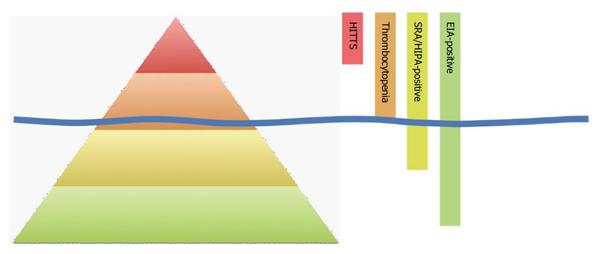Copyright
©The Author(s) 2016.
World J Transplant. Mar 24, 2016; 6(1): 165-173
Published online Mar 24, 2016. doi: 10.5500/wjt.v6.i1.165
Published online Mar 24, 2016. doi: 10.5500/wjt.v6.i1.165
Figure 1 The frequency of antibody seroconversion, activating heparin-induced thrombocytopenia antibodies (serotonin release assay/heparin induced platelet activation assay), thrombocytopenia, and clinically manifest heparin-induced thrombocytopenia thrombotic syndrome are illustrated as an “iceberg”[4,9,10].
The waterline indicates the threshold between positive laboratory findings and clinical appearance of HIT. HIT: Heparin-induced thrombocytopenia.
Figure 2 Modified iceberg model of the assumed frequency of antibody seroconversion, activating heparin-induced thrombocytopenia antibodies (serotonin release assay/heparin induced platelet activation assay), thrombocytopenia, and clinically manifest heparin-induced thrombocytopenia thrombotic syndrome according to the current knowledge on heparin-induced thrombocytopenia in solid organ transplant recipients.
HIT: Heparin-induced thrombocytopenia.
- Citation: Assfalg V, Hüser N. Heparin-induced thrombocytopenia in solid organ transplant recipients: The current scientific knowledge. World J Transplant 2016; 6(1): 165-173
- URL: https://www.wjgnet.com/2220-3230/full/v6/i1/165.htm
- DOI: https://dx.doi.org/10.5500/wjt.v6.i1.165














